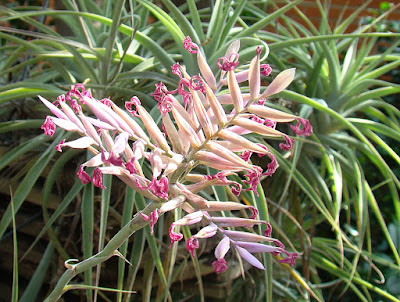Tillandsia cacticola is native to northern Peru. It is found at altitudes above 2000 meters above sea level. This plant is remarkable because it is famous for its ability to grow on rocks and cacti (hence its name).
Tillandsia cacticola is an air plant species of the genus Tillandsia. This species was described by Lyman Bradford Smith in 1954.
IDENTIFY TILLANDSIA CACTICOLA AIR PLANT
Tillandsia cacticola is native to northern Peru. It is found at altitudes above 2000 meters above sea level. This plant is remarkable because it is famous for its ability to grow on rocks and cacti (hence its name).
It is an epiphyte or saxicolous, which reaching 50 cm in size, slightly caulescent with quite numerous, flexible, almost 10 cm long leaves that form a rosette. The leaves are of a beautiful whitish green.
This air plant blooms from the very large (more than 50 cm),digitized inflorescence with flat and very scaly ears. The bracts of the flowering stem are scaly, imbricate, with filiform apex. The primary bracts are wider, scaly and pinkish. The floral bracts are slightly scaly, pink to pinkish, becoming almost purple at the end of flowering. The inflorescence of this species is very similar to that of Tillandsia straminea, but is distinguished by tighter floral bracts and often more compact appearance.
The flowers are distich, non-tubular, 1 cm wide, sometimes a little more. The flowers are beautiful, white with the tip of dark purple petals. The stamens and pistil are included. Flowering is long-lasting (several months if the plant is large).
TILLANDSIA CACTICOLA AIR PLANT CARE AND CULTURE
Cultural information should only be used as a guide, and should be to be adapted to suit you. Your physical location; where you grow your plants, how much time you have to devote to their care, and many other factors, will need to be taken into account. Only then can you decide on the cultural methods that best suit you and your plants.
Light:
Tillandsia cacticola requires good light and enjoys full sun (avoid the afternoon in summer if the plant is young or has not been used). This species is easy enough to cultivate as long as it provides a lot of light. However, and contrary to what we see in the natural state (full sun, very dry atmosphere), it only moderately appreciates the extreme conditions in cultivation if the plant is young.
Temperature:
The required temperature ranging from 10 to 32°C. Get it early enough in the fall if you grow it outside, so that it does not face night temperatures below 4 or 5 ° C, especially if it is wet. The plants can faced temperatures close to 0 ° C (sheltered and dry) for a few hours without damage.
Humidity:
This species need the moderate level of humidity. Good aeration is required, the plant must dry quickly (in less than an hour).
Substrate, growing media and repotting:
Tillandsia cacticola refer to be mounted on a solid substrate that does not retain water. Place the plant very close to a window indoors in the winter and preferably outside the summer in a sunny situation. You can glue the plant directly to the surface with a strong adhesive, or you can wire the plant to the base. Don't cover the base of the plant with moss or it may rot. It can be grown on almost any imaginable decorative mount, including shells, rocks, slate, driftwood, etc. Group them in decorative clumps for maximum effect.
Watering:
Twice a week in summer, once a week in winter according to the luminosity and the ambient humidity. Obviously when it rains and if you grow it outside, it counts as a watering.
Fertilizer:
This air plant can be fertilized with the moderate doses. 1 to 2 times a month in the summer and 1 time a month in the winter.















COMMENTS